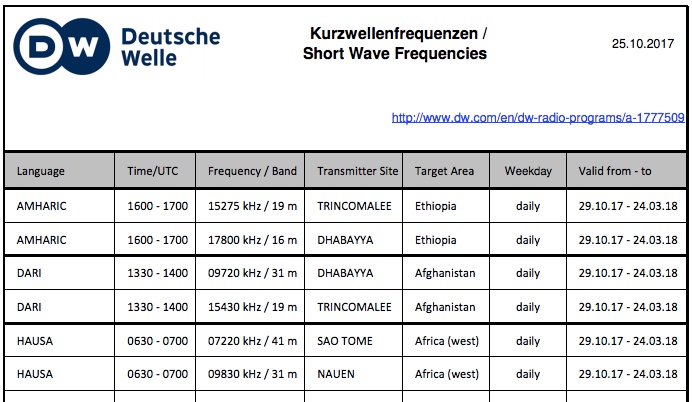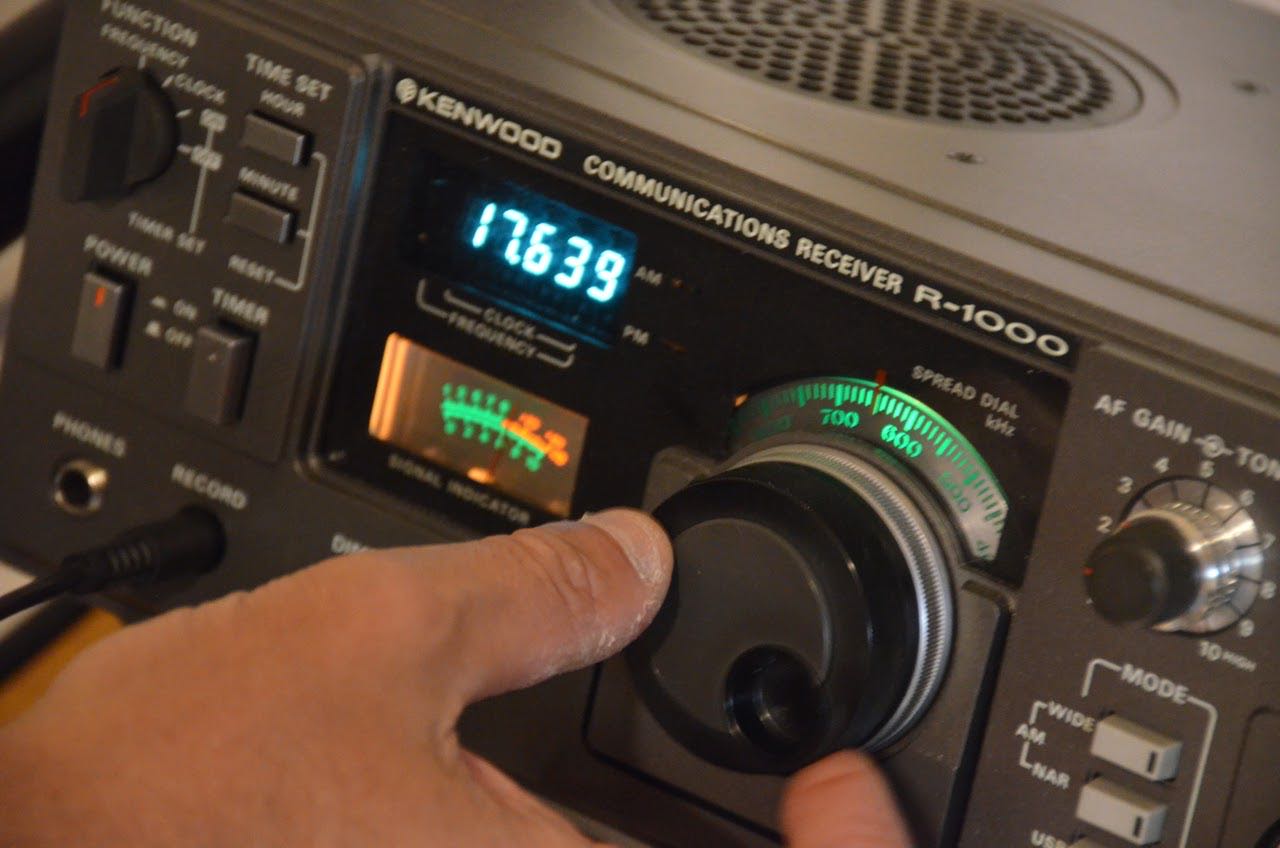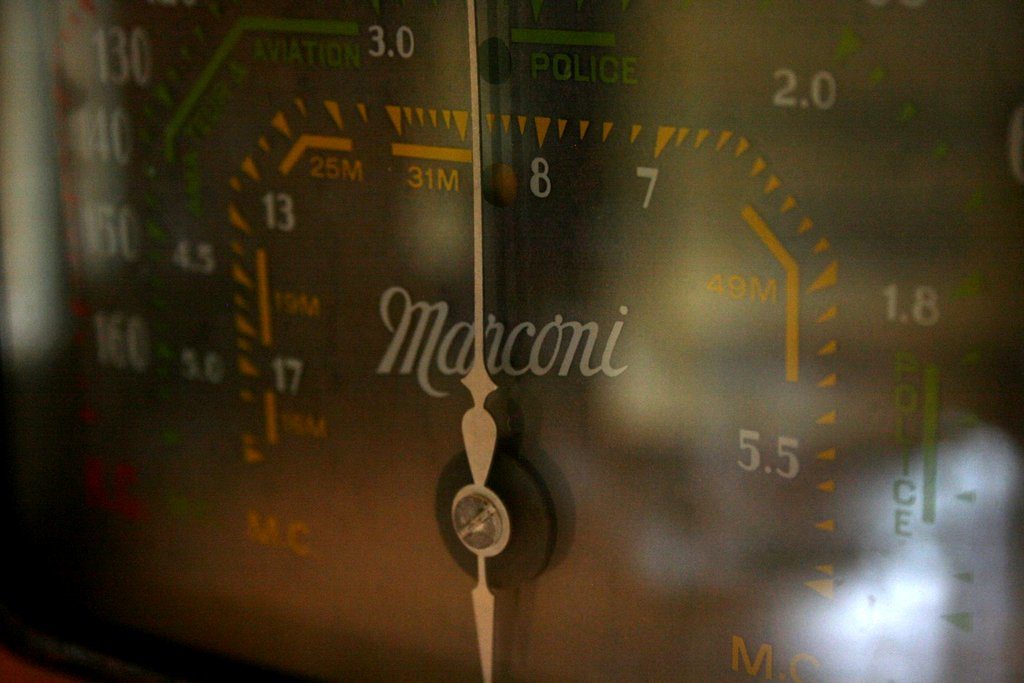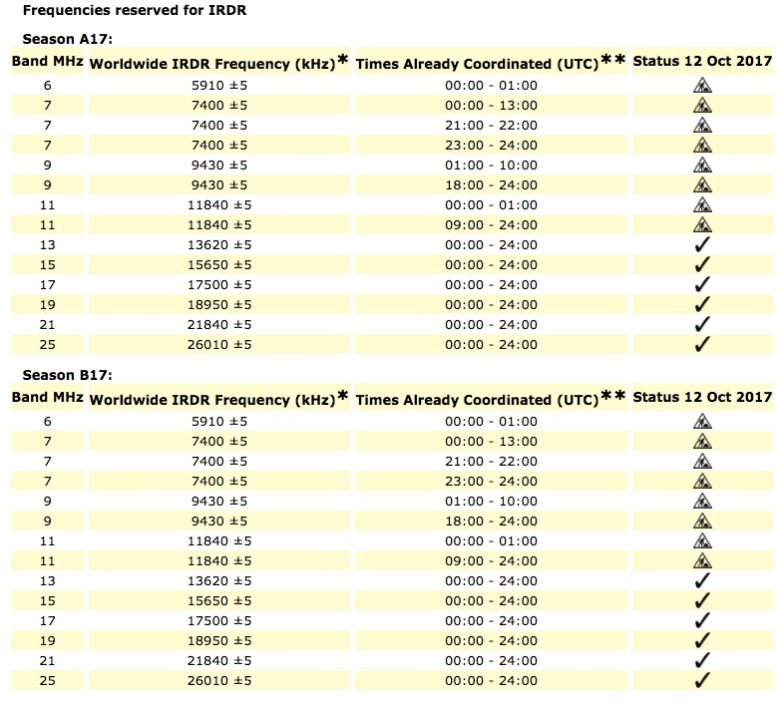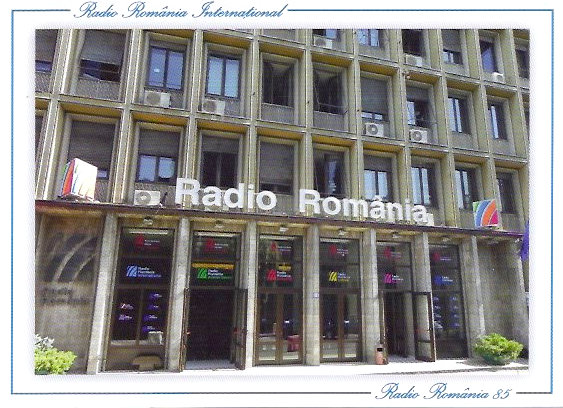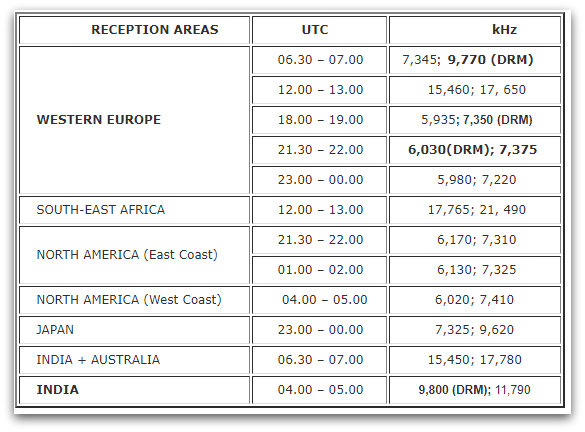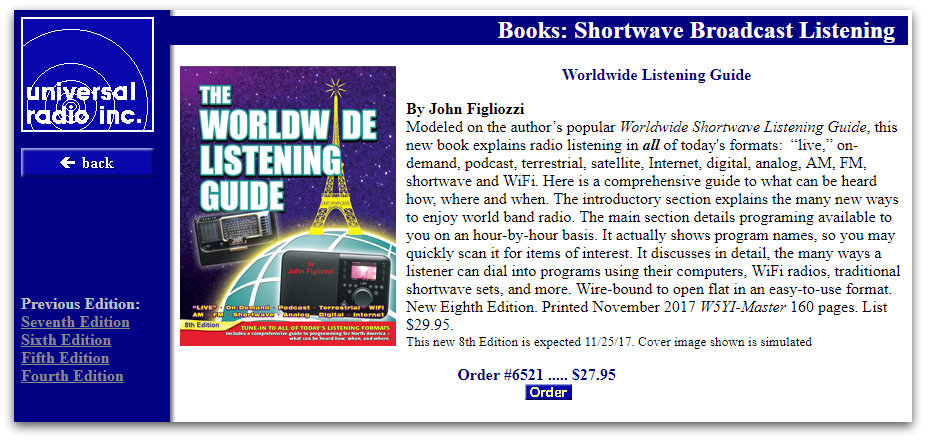
Many thanks to SWLing Post contributor, Troy Riedel, who notes that Universal Radio is now taking pre-orders for the 8th edition of the Worldwide Listening Guide by John Figliozzi.
Category Archives: Schedules and Frequencies
Deutsche Welle may have dropped English language shortwave service
Many thanks to SWLing Post contributor Paul Walker who notes that, according to their latest schedule, Deutsche Welle has dropped English language shortwave services. Paul shared the following links:
Current shortwave schedule:
http://www.dw.com/downloads/41133929/b17webkw.pdfLinked from this page:
http://www.dw.com/en/dw-radio-programs/a-1777509English only gets one hour a day on satellite
http://www.dw.com/downloads/41133930/b17websat.pdf
Changes to Radio Exterior de España shortwave frequencies
Many thanks to SWLing Post contributor, David Iurescia (LW4DAF), who notes that Radio Exterior de España’s has announced winter frequency changes on their website.
David passed along an English (Google) translation of the REE notice:
Due to the winter time change, from October 29, Radio Exterior of Spain changes its emission frequencies in Short Wave.
From Monday to Friday, between 19 and 23 hours, universal time coordinated, Radio Exterior of Spain will offer its emissions in 11,685 kilohertz for West Africa and the South Atlantic. At 15,390 kilohertz for South America and the Pacific Ocean. At 9,690 kilohertz for North America and Greenland. And at 15,500 kilohertz for the Indian Ocean, Middle East and Great Sun.
On weekends, for West Africa and the South Atlantic, between 15 and 19 hours, universal time coordinated, at 17,755 kilohertz; and between 19 and 23 hours at 11,685 kilohertz.
On Saturdays and Sundays, between 15 and 23 hours, at 15,390 kilohertz for South America and the Pacific Oceans; at 9,690 kilohertz for North America and Greenland; and 15,500 kilohertz for the Indian Ocean, Middle East and Great Sun.
These are the frequency changes of the Spanish Foreign Radio Broadcast Wave emissions that will come into effect on October 30 due to the time shift to the winter.
Radio Exterior of Spain can be followed through satellite radio in all parts of the planet 24 hours a day uninterruptedly:
SES Astra 1M: frequency 11,626.5 MHz. Vertical polarization.
Hispasat 30W-5: frequency 12,015 Mhz. Vertical polarization.
Asiasat 5: frequency 3,960 Mhz. Horizontal polarization.
Eutelsat 5 West A: frequency 3,727 Mhz. Circular polarization.
Intelsat Galaxy 23: Frequency 4,191.35 Mhz. Vertical polarization.
Radio Exterior of Spain is heard on the Internet, in streaming or in the podcast of all its programming.There are also mobile applications (link for Apple app or Android) for mobile applications, such as phones and tablets. And from any municipality and province of Spain you can enjoy, through television, Radio Exterior of Spain by DTT.
Thanks for the tip, David!
This weekend: European Music Radio Relays & More
Many thanks to SWLing Post contributor, Tom Taylor, who shares the following schedule:
EMR Relays + More
Scheduled Transmissions from Radio City are:
3rd Saturday at 08.00 to 09.00 UTC on 9510 kHz with Repeats all other Saturdays
4th Saturday at 12.00 to 13.00 UTC on 7265 kHz via Hamburger Lokalradio
Contact address remains: [email protected]Saturday HLR:
06.00 to 10.00 UTC, on 6190 KHz
10.00 to 16.00 UTC, on 7265 KHzEuropean Music Radio Relays:
14th October 2017:
08.00 to 09.00 UTC on 6070 KHz – to Western Europe via Ch 29215th October 2017:
08.00 to 09.00 UTC on 9485 KHz – to Western Europe via MVBR
19.00 to 20.00 UTC on 6070 KHz – to Western Europe via Ch 292Internet Repeats on 15th October 2017:
EMR will have this months Transmissions via two streams running at the following Times:15.00, 17.00, 19.00 UTC
http://nednl.net:8000/emr.m3u will be on 96 kbps /44 KHz stereo for normal listening
http://nednl.net:8000/emr24.m3u will be 24 kbps / 22 KHz mono will be especially for low bandwidth like mobile phones.European Music Radio Relay :
21st October 2017:
21.30 to 22.00 UTC on 7490 KHz – to Central & North America via WBCQSunday HLR:
09.00 to 12.00 UTC on 9485 kHz
E-mail: [email protected] Thank you!
HLR FM-DAB+ Program via the Internet : www.hamburger-lokalradio.net Daily 24 hThe Mighty KBC:
Programme Schedule http://www.kbcradio.eu/index.php?dir=shows/6095
Please Email: [email protected] Thank you!Hobart Radio International:
Full Schedule A17: http://www.hriradio.org/p/current-schedule.html
Please Email: [email protected] Thank you!Radio Channel 292 Transmission schedules:
http://www.channel292.de/schedule-for-bookings/
Radio Mi Amigo Transmission schedules:
For outside the listening area please try the Twente/Netherlands Web RX at http://websdr.ewi.utwente.nl:8901/
You can also hear many European free and alternative stations via the Internet at: http://laut.fm/jukebox
Good Listening! 73s, Tom
HFCC: International Radio for Disaster Relief (IRDR) schedule
(Source: HFCC via Larry W)
International Radio for Disaster Relief (IRDR)
Humanitarian Aspects of HFCC Activities
From its infancy since 1920s shortwave radio has been associated with its potential of being a communication tool in emergencies. This use of shortwave radio is still very much present among amateur radio enthusiasts for example, who discovered its long distance properties early in the twentieth century. Amateur radio provides a means of communication on shortwaves and other frequencies “when all else fails”. This role of amateur radio is well recognised, valued and appreciated both by the public and by the world institutions managing and regulating the use of the radio spectrum.
In contrast the huge technical potential of international shortwave broadcasting that operates transmitter facilities tens, or hundred times, more powerful than those of amateur radio, remains almost unused in emergencies. At the moment when local and even regional communication and information networks are needed most, they are destroyed or overloaded and the population suffers from an information blackout. Shortwave radio is capable of remaining the only source of information.
Although the life-saving role of radio broadcasting is widely recognised by the public, and confirmed by surveys conducted after the recent disasters – and even acknowledged by world leaders – no concrete projects have been ever designed and no regulatory framework has been developed.
That is why the HFCC – International Broadcasting Delivery in co-operation with the Arab States and Asia-Pacific broadcasting unions are working on an International Radio for Disaster Relief (IRDR) project that is based on the system of online co-ordination of frequencies managed by the HFCC in accordance with International Radio Regulations.
The HFCC is aware of the humanitarian aspects of international broadcasting. It pointed out in 2012 – as the UNESCO partner for the preparation of the World Radio Day – that terrestrial shortwave radio in particular is still considered as a powerful communication and information tool during emergency situations. Read more >>
Receivers are inexpensive and require no access fees. Shortwave radio is important for people living in remote and isolated regions of the world. It reaches across the digital divide to the most disadvantaged and marginalised societies. This is also in keeping with the Declaration and Action Plan of the World Summit on the Information Society.
The annual edition of the World Disasters Report of the International Red Cross and Red Crescent Societies (IFRC) issued in October 2013 stressed again that with only 6 percent of people in low-income countries using the internet in 2011 the digital divide is still stark, and access to low cost media technology is really the key.
The HFCC is a strong advocate for incorporating terrestrial broadcasting permanently on the disaster risk reduction agendas of the ITU and other UN agencies and institutions. It submitted two documents for the ITU-R Working Party 6A November 2013 meeting:
HFCC – The Importance of Terrestrial radio in International Broadcasting
HFCC – The International Radio for Disaster Relief ProjectBoth documents are annexes in Section 8 of the ITU-R Study Group 6 Report BT.2266 “Broadcasting for public warning, disaster mitigation and relief”. The report can be downloaded via this link.
A workshop was held during the November 2013 meeting addressing these issues. The web site of the Emergency Broadcasting Workshop can be accessed here. The web site also contains copies of all the presentations that were made at the workshop, and a Video interview with Christoph Dosch, Chairman of ITU-R Study Group 6 (Broadcasting service)
The HFCC has applied for membership in the CDAC (Communicating with Disaster Affected Communities) Network in keeping with the conclusion of the debate on emergency communication during the Bratislava B13 Conference. Read more >>
The HFCC is staying in touch with the Information and Communication Sector of the UNESCO agency on the preparation of the World Radio Days that are celebrated each year on February 13th.
Humanitarian aspects of terrestrial broadcasting were also on the agenda of the Global Kuala Lumpur conference in January 2014. Read Opening Remarks.
Radio Romania International: 2017-2018 Winter Broadcast Frequencies
Many thanks to SWLing Post contributor, David Iurescia (LW4DAF), who shares the RRI 2017-2018 Winter Broadcast Frequencies (effective 29/10/2017 to 24/3/2018):
You can also listen to RRI’s English language programming live over the internet using the same SW broadcast schedule given above. All you need to do is go to the “RRI Live!” section in the top-right of our website, choose channel “2” for English and then select your desired audio format (WMA, MP3 or ACC).
Listen to English language programming on demand via the RRI website
RRI broadcasts in English are also available for listening on demand via our website. The “On Demand” feature is located immediately below the “RRI Live!” section in the top-right of the RRI homepage. To listen again to a programme all you need to do is select the date of broadcast from the drop-down list and then click the desired programme. Our programmes become available for listening on demand two hours after the original broadcast.RRI and social media
RRI can also be found on Facebook, Twitter, YouTube, Vimeo, Dailymotion, Google+, Flickr, Pinterest, LinkedIn, Tumblr, SoundCloud and Instagram.
RRI via mobile phone in the US and on TuneIn
Did you know that if you’re in the US you can also listen to RRI broadcasts on your mobile phone? Our English language programmes are available both live and on demand via the following AudioNow “call-to-listen” phone number: 716.274.2526. Calling this number incurs no extra charge above the equivalent of a standard US mobile phone call.
Our programs are also available on TuneIn (Radio Romania International 1)
Click here to view on RRI’s website.
Skywave Radio Schedules now on the Google Play store
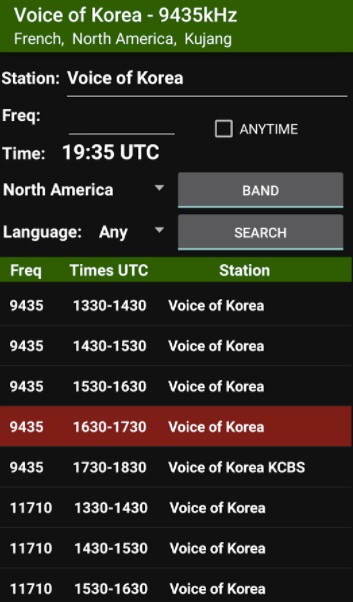
Skywave Schedules App will allow you to search a comprehensive, regularly updated, database of shortwave radio broadcasts.
Many thanks to SWLing Post contributor, Cap, who has just notified me that his shortwave radio schedules app for Android–Skywave Radio Schedules–is now available via the Google Play store.
You might recall that Cap first shared this app in Beta form and invited us to share feedback and comments. Cap has spent weeks incorporating our suggestions and making changes in the background–Skywave Radio Schedules feels refined and responsive. Best yet? It’s free and has no ads. Amazing.
Cap does note that you should uninstall any previous versions of this app before installing it from the Google Play store.
Thank you, Cap! Great job making this app a reality.
Click here to view Skywave Radio Schedules on the Google Play store.

